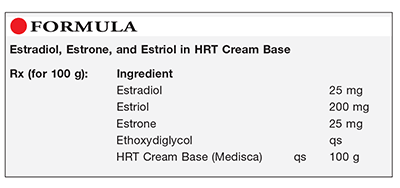US Pharm. 2016;41(9):27-28.

Method of Preparation: Calculate the quantity of each ingredient for the amount to be prepared. Accurately weigh each ingredient. Combine the estradiol, estriol, and estrone with a few drops of ethoxydiglycol and mix well to form a smooth paste. Geometrically, incorporate the HRT Cream Base to final weight and mix well. Package and label.
Use: This preparation has been used in hormone replacement therapy (HRT).
Packaging: Package in tight, light-resistant containers.1
Labeling: Keep out of reach of children. Use only as directed. Discard after ____ [time period].
Stability: A beyond-use date of up to 90 days has been used for this preparation when it is stored at room temperature.2
Quality Control: Quality-control assessment can include theoretical weight compared with actual weight, apparent pH, specific gravity, active drug assay, color, texture-surface, texture-spatula spread, appearance, feel, rheologic properties, and physical observations.3
Discussion: Estradiol (oestradiol, beta-estradiol, C18H24O2, MW 272.38) occurs as white or creamy-white, odorless, hygroscopic, small crystals or crystalline powder. It is practically insoluble in water, but is soluble 1 g in 28 mL of alcohol. Estradiol is sparingly soluble in vegetable oils. It should be stored in airtight containers at controlled room temperature and protected from light.4,5
Estriol, a naturally occurring estrogen, is claimed to have a selective action on the cervix, vagina, and vulva and to have relatively little effect on the endometrium. It is a crystalline powder that is practically insoluble in water but is soluble in alcohol and vegetable oils. In the body, estradiol is reversibly oxidized to estrone, and both estradiol and estrone can be converted to estriol.5,6
Estrone is a naturally occurring steroidal estrogen prepared either from the urine of pregnant mares or from the Mexican yam (Dioscorea). Estrone occurs as small, white crystals or as a white to creamy white, crystalline powder that is odorless and practically insoluble in water. It is soluble to the extent of 4 mg/mL in alcohol and is soluble in vegetable oils. Estrone is used in the treatment of hypogonadism, primary ovarian failure, vasomotor symptoms of menopause, prostatic carcinoma, inoperable breast cancer, kraurosis vulvae, and abnormal uterine bleeding caused by hormone imbalance.5,7
Ethoxydiglycol (C6H14O3, CH2OHCH2OCH2CH2OC2H5, MW 134.20) is also called diethylene glycol monoethyl ether, diethylene glycol ethyl ether, Carbitol, and Transcutol. It occurs as a colorless liquid with a mild, pleasant odor. Ethoxydiglycol is hygroscopic, and it is miscible with water and with common organic solvents. It has a density of 1.0272 and a boiling point of 195°C to 202°C, and it is combustible. Ethoxydiglycol is nonirritating and nonpenetrating when applied to human skin, and it is used as a solvent, solubilizer, and cosurfactant.8
HRT Cream Base occurs as a smooth, white to off-white, odorless cream. It is very slightly soluble in cold water. Developed for use as a topical or vaginal delivery system for hormones, HRT Cream Base is a vanishing oil-in-water emulsion formulated with a natural antioxidant and emollient. It is free of alcohol, petrolatum, and oil, and it has excellent moisturizing and penetration-enhancing capabilities. In addition to being a suitable vehicle for hormones, HRT Cream Base is also ideal for dermatologic applications. HRT Cream Base is highly absorbent and should be used with lipophilic drugs only. It may be applied to mucous membranes. Its pH ranges from 5.60 to 7.25, and the specific gravity ranges from 0.95 to 1.10.9 HRT Cream Base is suitable for use in both women and men.
REFERENCES
1. U.S. Pharmacopeia/National Formulary [current revision]. Rockville, MD: U.S. Pharmacopeial Convention, Inc; August 2016.
2. Basu Sarkar A, Kandimalla A, Durga Paruchuri R, Dudley R. Ninety day chemical stability of compounded estradiol, estrone, and estriol combination and beyond-use date. J Pharm Sci Innov. 2012;1:23-26.
3. Allen LV Jr. Standard operating procedure for performing physical quality assessment of ointments/creams/gels. IJPC. 1998;2:308-309.
4. Lacy C, Armstrong LL, Ingrim NB, Lance LL. Drug Information Handbook. 4th ed. Hudson, OH: Lexi-Comp, Inc; 1996:445-447.
5. Hardman JG, Limbird LE. Goodman & Gilman’s The Pharmacological Basis of Therapeutics. 9th ed. New York, NY: McGraw-Hill Education; 1996:1411-1437.
6. Reynolds JE, ed. Martindale: The Extra Pharmacopoeia. 30th ed. London, England: Pharmaceutical Press; 1993:1192.
7. Lacy C, Armstrong LL, Ingrim NB, Lance LL. Drug Information Handbook. 4th ed. Hudson, OH: Lexi-Comp, Inc; 1996:451-452.
8. Ash M, Ash I. Handbook of Pharmaceutical Additives. Brookfield, VT: Gower Publishing Ltd; 1995:484.
9. HRT Cream Base product information. Saint-Laurent, QC: Medisca.
To comment on this article, contact rdavidson@uspharmacist.com.





